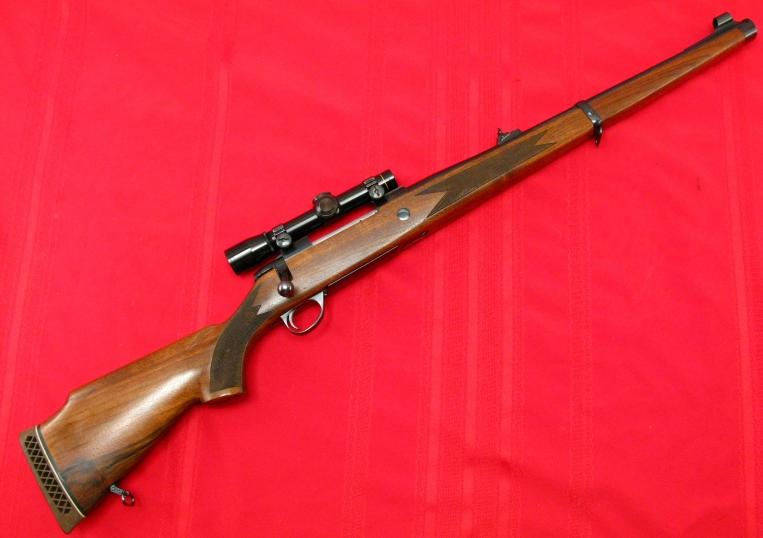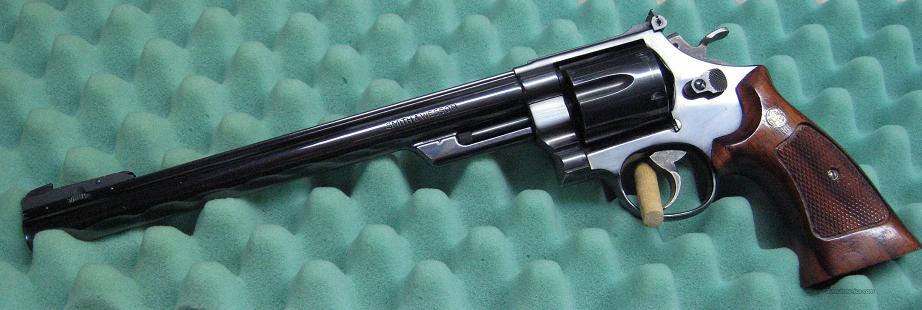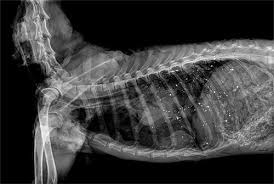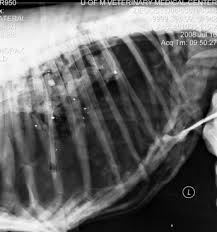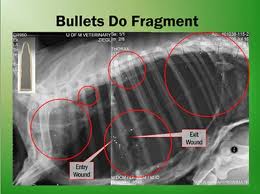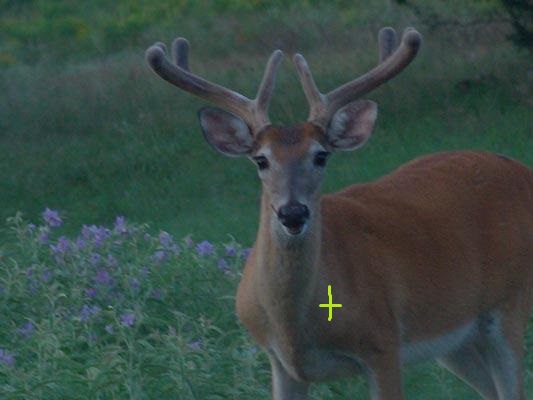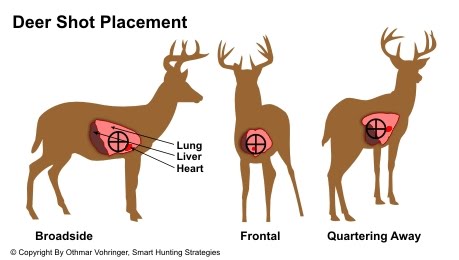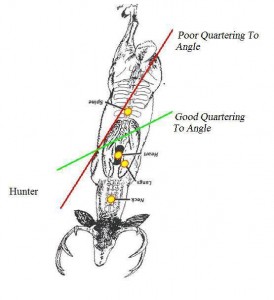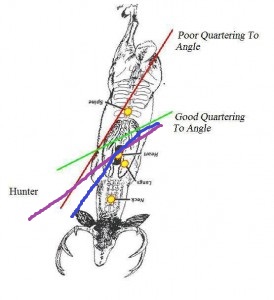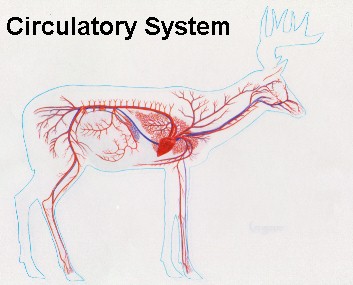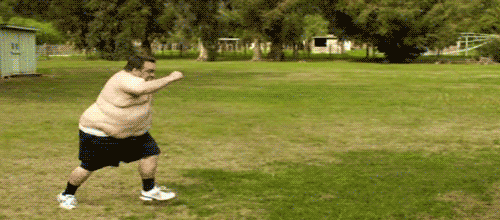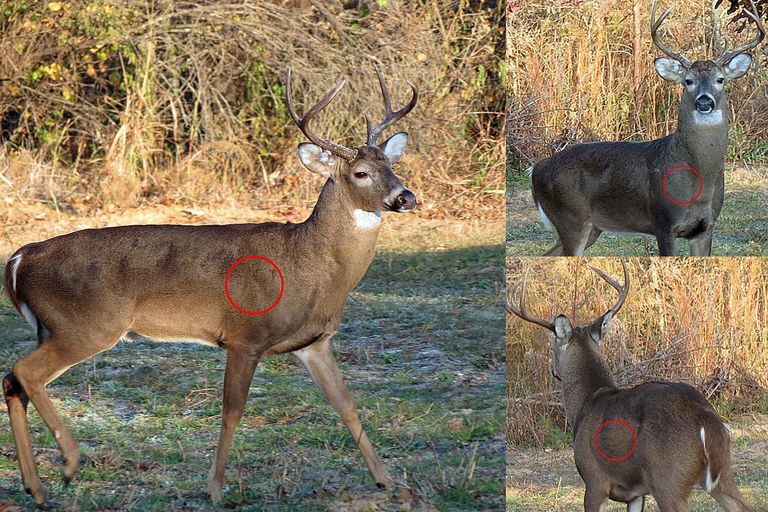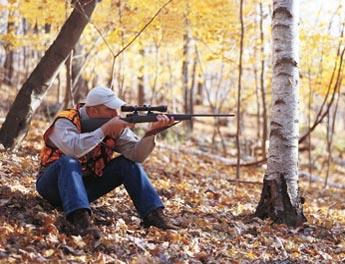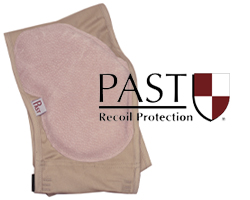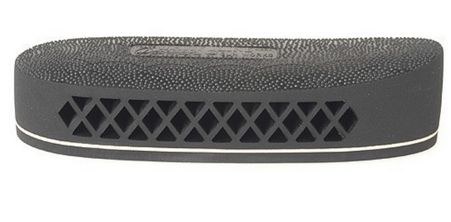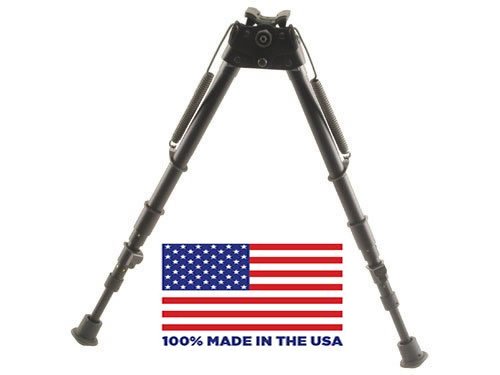Ive hunted deer, elk and hogs for close too ,5 decades,...
don,t get too concerned with the ability of the weapon you choose to do the job,
its mostly shot placement not velocity, energy and/ or bullet weight,
and your consistent ability to hit the games vitals that should concern you,
and of course, bullet construction, range and the games anatomy that matters, within reasonable limits,
every magazine article you read seems to stress the importance of hyper velocity and flat trajectory,
these factors help sell magazines and the newest super wiz-bang,
magnum rifles.
but the fact is that people were killing game very effectively,
with calibers like the 45/70 and 30/30 win, and 30/40 krag for 70-120 years,
before the newest magnums were introduced,
if you have some hunting skills you can kill game with archery equipment that has under 300fps,
and under 70 yard effective range that never reaches 150 ft lbs of energy.
THAT BEING SAID, the CALIBER, POWER LEVEL AND projectile should be matched to the intended target,
and having a bit more bullet weight or velocity seldom hurts your results either. YOU SHOULD KNOW YOUR GAME ANATOMY WELL!,
and BE able to do the job,
OF CORRECTLY PLACING A SHOT THRU THE VITALS,
under less than ideal conditions, of range and FROM entrance angles
THAT ARE NOT IDEAL,
and you must know the games anatomy,
and if you can,t consistently place shots accurately under field conditions,
what you carry won,t matter much!
under ideal conditions, almost any centerfire cartridge can kill almost any game, yet
theres ALWAYS going to be game thats well hit with any bullet design that won,t instantly fall on bullet impact,
so don,t expect that the result of a well placed hit will always DROP GAME INSTANTLY,
BUT I FIRMLY BELIEVE, AFTER DECADES OF HUNTING,
that there are advantages in use of the heavier bullets in the .260-.300 plus sectional density range,
that give you some advantages and consistency.
you should select a weapon and caliber based on what will work under the least likely,
or least favorable and not the best possible conditions of range and entrance angle on the intended game.
if you can,t use the weapon of your choice,
to quickly and effectively kill from almost any angle,
at any reasonable range you might want to rethink your choices
carry the caliber and rifle you trust,and feel confident in,
we all have different experiences, and tend to feel we need certain rifles,in our hands to feel were well equipped,
if theres one fact I've learned over 43 plus years of hunting elk and deer,
its that its the skill of the guy using the rifle,
and his confidence in his equipment, not the caliber that maters the most.
personally Id select something in the 338-358-375 caliber for elk hunting ,
and I've seen excellent results from the 338/06 and 35 whelen,
but having seen a couple elk killed with a 257 Roberts and a 6.5mm Swedish Mauser,
and even a 44 mag revolver,
I know its not so much the rifles power as it is the skill of the hunter using it,
too get into position and range to precisely place the shot in the games vitals!
IM betting your weapons effectiveness is the result of punching large holes in vital organs and massive blood loss myself, and I doubt it matters all that much if the projectile started out at 3000fps or 1200 fps as long as it passed thru and destroyed those vital organs and left a big jagged hole in its path.
while I personally prefer the 338-375 caliber cartridges throwing 200-270 grain bullets, they are not required.
Ive killed and seen far too many elk killed really dead with a 270 cal/150 grain and 30/06 cal rifles using 180-200 grain bullets to ever suggest they are not fully up to the job in the hands of a decent rifle shot, and I know most of the group I hunted with for decades used only speer, hornady, Remington and Winchester bullets......and they all worked fine when placed correctly I can,t think of any hunt Ive been on in 43 years that either of those rifles properly loaded and used correctly would not have allowed me to collect game.
the guys in my elk hunting group have tried most of the popular calibers from 257 Roberts to a 458 win and there,s one consistent fact, its the guys using the rifles skill that maters most.
and theres more guys using 35 whelens and 30/06 rifles now than magnums, Im the last guy in camp still using a 340wby or 375 H&H, there used to be several 7mm and 300 mags used, but as the guys aged and got more experience the 30/06 and 35 whelen seem to have become rather standard
Ive used a 80 lb bow with 560 grain arrows and 3 blade broad heads, a 257 Roberts, a 257 wby,a 270 win,a 300 wby , a 375 H&H, a 45/70 and a 62 caliber muzzle loader,
and a dozen other weapons the only thing that was in common was shot placement and the results, they all left a big bloody hole,
along the projectiles path thru the games body, and destroyed internal organs.
where you hits always more important than what caliber you select,
my friends dad whos near 80 years old dropped a small bull within a few feet of where he spotted it , while shooting a 257 roberts loaded with 100 grain speer bullets, on bullet impact the bull trotted about 20 yards and then got wobbly and fell , the shot was easily 240 yards, or a bit more as it was 270 plus paces to the bull from where we stood. and he made the shot leaning over a branch on an aspen with his Winchester 70 and weave 4x scope.
he hit the bull in the near side lung and angled back into the liver
that was back in the 1990s and was the last bull he ever took.
that shot really impressed me, not so much as to accuracy but how such a small cartridge could be so effective, but Ive seen guys make similar shots with 7mm and 30 calibers that had elk run further.
when I first started hunting mule deer, I read everything I could find, and I made a choice to go with a custom built ,257 wby, I had a ruger #1 built by shillen, in caliber 257 wby with a 28" barrel, it was and is accurate, it killed very effectively, it also eroded the barrel throat very slightly, in under 200 cartridges.
and while it made hits out at long range fairly easy as trajectory guess work was not all that critical out to at least 350 yards when I sighted in a couple inches high I eventually realized I had used it exactly twice in 40 plus years at ranges over 500 yards to kill mule deer and that probably 90%-95% or more of the deer Id killed had been dropped from under 300 yards.
now I don't regret building the rifle but ,
I don't see any huge advantage over a 270 win for hunting mule deer.
why, do a ballistic calculation, I doubt you'll find a 4" difference in drop even out at 500 yards between a 120 grain .25 cal. and a 130 grain .277 cal.
being a bit pragmatic I've tested a fairly wide selection of calibers on game and while Ill point out that its the bullet that does all the work and its correct shot placement ,and knowing your games anatomy that's the two most critical factors, it soon became obvious that a well constructed bullet design that held together had advantages and that as impact velocities increased too much over about 3000 fps, bullet performance seemed to rapidly fail in many cases...obviously bullet design and construction, range to the target and what your hunting effect the results, but I'm forced to point out that the my experience shows that the 257-270-30 calibers are about ideal on deer , and the slightly larger 30-375 calibers seem better suited to the elk THAT CAN EASILY WEIGHT 3-4 TIMES MORE THAN DEER.
looking around for a good answer I found this...
"It's very difficult to get a lighter bullet to have as much momentum as a smaller bullet. Momentum is mass times velocity. But energy is mass times velocity SQUARED. Therefore, to double the momentum of a bullet while keeping its mass constant, you have to quadruple its kinetic energy. To quadruple the momentum, you'd need to increase the energy by a factor of sixteen. So that's the momentum story.
Id suspect both where the bullets placed and which bullet you used , and the hunters knowledge of the games anatomy, has a huge effect on results , I've used both the 35 Whelen and 45/70 on both deer and elk in the past and had very good results.
now I've seen several deer and elk shot with a 257 Roberts and 270 Winchester rifles also and the same things hold true, place your shots well and use a decent bullet and any of the mentioned calibers work, pure physics suggests a larger more massive projectile, that expands but maintains most of its physical integrity has some potential benefits in causing more consistent and deeper wound damage, on the larger animals but I've seen a 257 Roberts dump an elk from 200 yards, in seconds after bullet impact, quite convincingly and the same thing happen with my 45/70 so I'm not overly concerned with head stamps, just accuracy and consistency.
maybe its just because I was employed for 4 decades as an engineer ,
but I've always made the choice to not take things in advertising seriously,
and preferred to deal in facts , you can look up load data,
projectile sectional density, ballistic coefficients, rifle weights,
and damn near anything else you need to compare any two cartridges
what youll find in most cases is that similar cartridges with similar projectile weight and diam and velocity,
produce similar performance. its not going to make a bit of difference in the field,
if you add or subtract a 100 fps or 5 grains of bullet mass.
what does make a difference is the rifles operator skill's,
at placing a shot carefully and the bullets physical properties,
example alloys used jacket thickness and impact velocity.
you can,t ignore physics, heavier mass and higher velocity carries more energy.
you should not ignore decades of field results, theres very few modern cartridges,
that provide any significant advantages over decades old designs like,
the 22 hornet, 22-250, 25/06 , 30/06 , 300 wby or 375 H&H.
step back mentally any time someone is bragging about the newest super zapper,
ask yourself if your current rifle has ever failed to perform well,
or if an extra few inches of flatter trajectory would make much difference.
especially if you realize that the vast majority of game is killed at well under 250 yards.
use the calculators and you'll soon realize most NEWER/BETTER- += marketing
the 22 hornet, 22-250, 25/06 , 30/06 , 300 wby or 375 H&H. will do damn near anything that's needed to be hunted,
provided you place your shot correctly and limit the range and cartridge used, to the type of animal your hunting.
22 caliber cartridges are NOT meant for large game
(yes under very limited conditions and short range in the hands of a skilled shot,
they could work on deer)
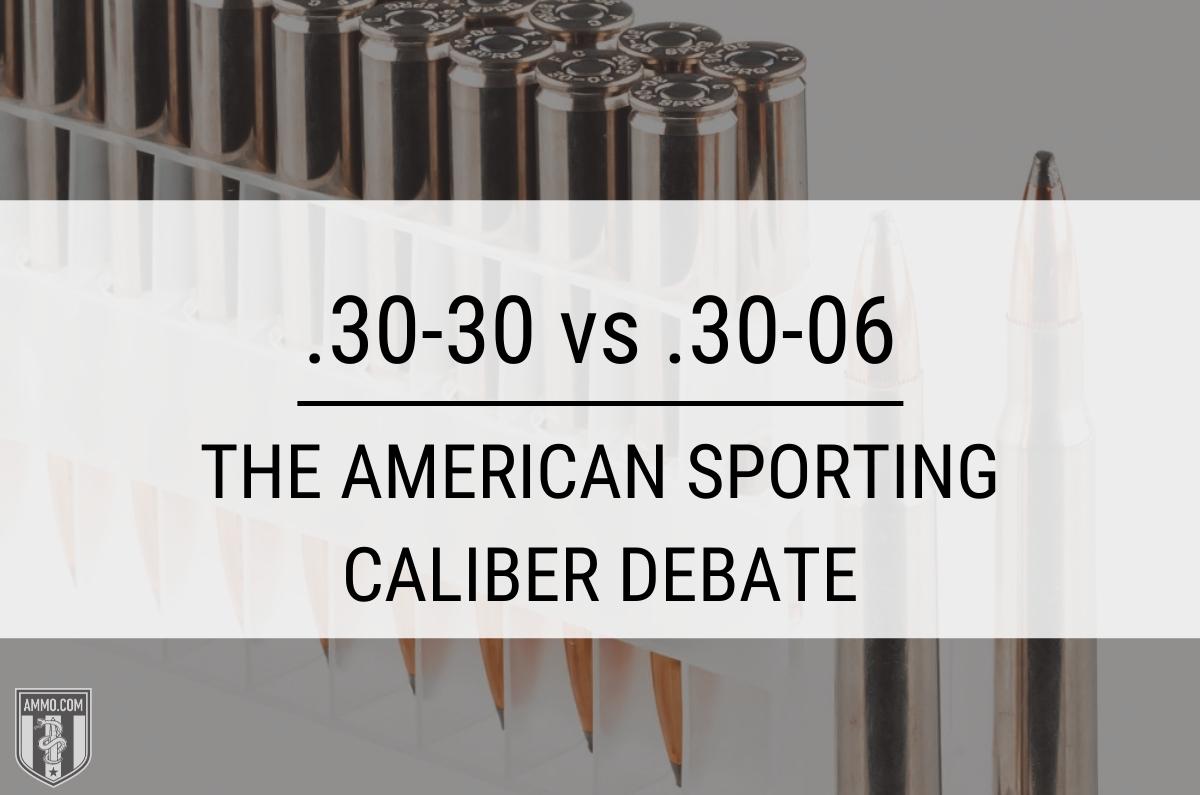
 ammo.com
ammo.com
https://www.hornady.com/team-hornady/ballistic-calculators/#!/
http://bergerbullets.com/twist-rate-calculator-3/
http://www.shooterscalculator.com/recoil-calculator.php
https://www.hornady.com/bullets/rifle/#!/
https://www.speer-ammo.com/products/bullets/rifle-bullets
https://www.hornady.com/support/load-data/
http://www.hodgdonreloading.com/
https://www.fieldandstream.com/12-best-rifle-cartridges-for-elk-hunting/
a great deal of the problems guys have with bullets results from trying to push a smaller and lighter in weight than ideal projectile to higher velocities than many bullet designs can reliably function at, you might be amazed at how consistent most cup & core bullet designs work if bullets are at least a .270 sectional density and if you don,t exceed 3000fps at the muzzle .
In terms of energy delivered to the target, a larger bullet still wins due to aerodynamic drag. Drag is a function of area. Suppose you have two bullets, A and B. They are made up of the same material and have the same shape, but bullet B is twice as large in all dimensions. It's volume and mass are therefore 8 times as large and it's drag (area) is 4 times as large as A's at the same velocity.
Suppose both are fired with the same initial kinetic energy. Since bullet A has only 1/8 of bullet B's mass, it's initial velocity will be sqrt(8) or 2.83 times higher. But aerodynamic drag, in addition to being a function of surface area, is also a function of velocity squared, so the lighter bullet will experience 8 times more drag (due to higher velocity) and (as we already computed) 4 times less drag (due to less area), for a net 2 times more drag for the lighter bullet.
It gets worse. The lighter bullet not only experiences twice the force of drag, it responds more to it. Remember F= MA, which can also be written A = F / M. In other words the lighter bullet, having 8 times less mass, will experience 8 times the deceleration when subjected to the same force. And since the drag force is actually twice as high, its decelleration will be 16 times that of the heavier bullet.
And even worse. The lighter bullet loses velocity at16 times the rate of the heavy one, but energy is a function of velocity squared, so it loses kinetic energy at 16 * 16 = 256 times the rate of the larger bullet.
Of course these are all figures for the initial conditions. As the bullets slow down they will be going closer to the same velocity, so the difference won't be quite as dramatic in the long run, but I think you get the picture.
Source(s):
Physics degree & have done work in fluid dynamics"
don,t get hung up on velocity just get the most accurate load
from a pragmatic view, I'm 100% sure there have been many dozens of elk killed with smaller 22 and 6mm rifles but that does not in my experience make them nearly ideal.
I personally have seen several elk killed very effectively with a 257 roberts, yet I would say after helping dress out those elk, and examining the internal damage that the 257 roberts is on the lower edge of the effective caliber range.
I hunt with a group of guys and most years theres 4-7 guys in camp and 3-4 deer or elk killed almost every year, this allows me to eventually see rather obvious trends in what results you can expect , and in my opinion after 45 plus years of dressing out game Id suggest a 270 win,308 win, or 7mm 08 loaded with a premium bullet is about the smallest calibers I see consistently put down game quickly and effectively
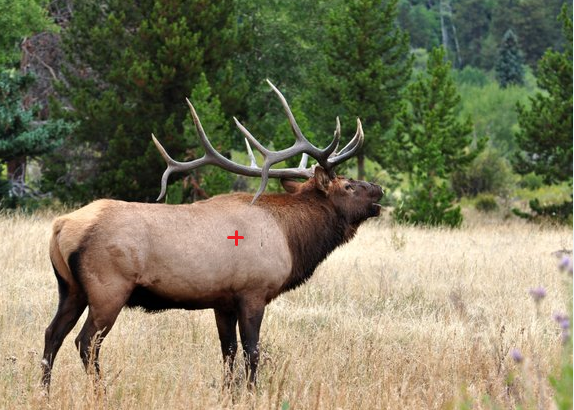
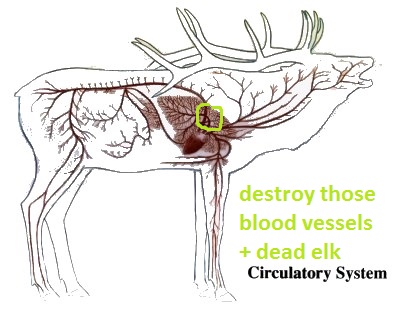
suggested bullet weights
357 mag= 158 grain-180 grain
41 mag= 220 grain-250 grain
44 mag= 270 grain-320 grain
45 caliber -300 grain-350 grain
480 caliber 350 grain-400 grain
50 caliber 400 grain-480 grain
bullet stability and twist rates
http://www.jbmballistics.com/cgi-bin/jbmstab-5.1.cgi
ballistic calculator
http://www.hornady.com/ballistics-resource/ballistics-calculator
these calculators can be really handy
ideally pistol velocity and the bullet design of the better hunting ,
cast bullets are most effective if the melplat (nose) is flat ans between 75%-80% of the bullet diameter, its a gas check design and its pushed to a muzzle velocity of at least 1350 fps but not too exceed about 1800 fps and have a bullet in the .240-.260 sectional density range.
jacketed hollow points should be used only on lighter weight game like deer.
remember the proper hard cast bullet will penetrate very effectively but it won,t expand rapidly, thus a knowledge of the games anatomy and locations of the vital organs is critical to rapid kills.
don,t be surprised if the first few large game animals you shoot run off with little indication they were hit, unless you place shots precisely handgun kills will resemble archery hunting and it will take 30 seconds for the game to bleed out, and in 30 seconds a scared injured deer can travel 200 yards making its recovery difficult.
but place shots precisely and if you used the correct projectile, distances will be much less.
https://www.fieldandstream.com/12-best-rifle-cartridges-for-elk-hunting#page-13
http://www.chuckhawks.com/sd.htm
Sectional Density Calculator
http://www.beartoothbullets.com/rescources/calculators/php/density.htm
http://www.hornady.com/ballistics-resource/external
bullet stability and twist rates
http://www.jbmballistics.com/cgi-bin/jbmstab-5.1.cgi
ballistic calculator
http://www.hornady.com/ballistics-resource/ballistics-calculator
http://www.midwayusa.com/product/740066 ... -box-of-20
even a fairly small cartridge like a 44 mag in a carbine or revolver can be quite effective in experienced hands inside of reasonable ranges, this federal 44 mag ammo looks like a good selection,if you don,t hand load, but id point out that with cast flat nose bullets performance is dependent on a good knowledge of the games anatomy and very precise ,and correct shot placement.
a shot thru the green dot will be quickly fatal, place the shot a bit higher and forward to destroy the shoulder and spine if your more concerned with anchoring the animal quickly than maximizing the venison,you pack out
have to point out a fact that all too many guys either ignore or never considered,
the projectile does ALL the work and damage! where you hit on the animals anatomy,IS CRITICAL
rapid lethality depend on where you place the projectile and how much damage is done.
and how much damage to vital organs and/or skeletal structure,being done,
should obviously be considered the major factor in potential lethality expected.
small fast expanding projectiles are devastatingly lethal... IF placed correctly,
IF THEY destroy the heart/lung area but the deer can still run very fast and
well for up to 10 seconds or so , and they may not leave much of a blood trail,
larger more heavily constructed projectiles, like a 180 grain 30 cal, or a 250 grain 358 bullet open slower and in a far more controlled manor ,
they may not do as much damage to the lungs,initially but they are 100% lethal if shots are well placed.
and frequently leave a blood trail.
and they do tend to be much more consistent and reliable at busting skeletal structure,
provide deep penetration through muscle and they do tend to leave exit wounds more often.
if you hand-load you can custom fabricate ammo specifically matching your requirements.
traditional brush cartridges like a 45/70 or 444 marlin can provide exceptional penetration,
(especially if loaded with heavy for caliber cast bullets,)(these can be depended on to exit deer )
or be loaded with fast expanding hollow point bullets to give rapid expansion.
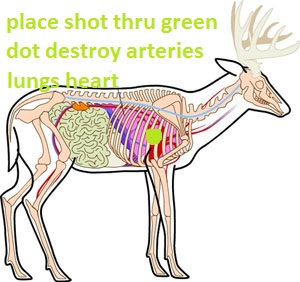
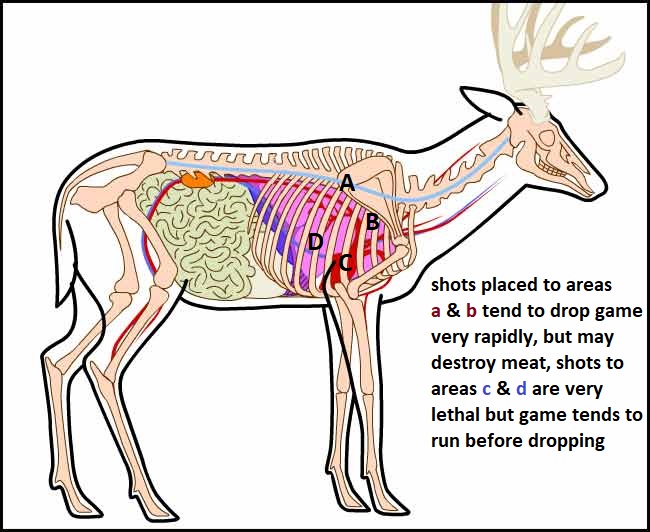
(1) where you place the shot is critical (know the games anatomy)
(2) use of a heavy for caliber projectile tends to greatly aid deep penetration
(3)the larger caliber and heavier the projectile, used the more consistent deep penetration
(4)deep penetration is a plus only if you use it to destroy vital organs,(heart/lungs)
and critical structure like spine and shoulders, (see #1)
PEOPLE HAVE KILLED 800LB GRIZZLES WITH A 22LR, BUT THAT HARDLY MAKE THAT THE IDEAL SELECTION
range effects the bullets retained energy, a 44 mag loaded with a 300 hard cast bullet at 50 yards makes a good deer & elk cartridge even at only 1200fps but stretch the range to 300 yards and its far less useful, and it carries far less punch, or momentum.
if your looking for a decent caliber/cartridge to hunt with, you'll be well served to do a bit of research on the average ranges, and game anatomy your intending to hunt ,and select a commonly used cartridge used for that game, you can easily get by with only a few common calibers, like the 22lr,223 rem,25/06,30/06,300wby, 338 mag, and 20ga,3" 12 ga for all north American hunting, and obviously there's a hundred other choices, but for big game a simple combo of two rifles , similar to,a 270 win loaded with a good 150 grain bullet and a 338 mag loaded with a good 250 grain bullet will handle 99% or more north American big game hunting conditions in skilled hands, either caliber could be used for most conditions or a compromise like a 35 whelen in a good rifleman's hands could also be very effective.
Id suggest selecting a cartridge with minimums of 150 gain bullet weight and 2500fps muzzle velocity and you don,t need more than 3000fps and 270 grains of bullet for anything I can think of in north America.
average both and you get about 210grains of bullet at about 2750fps and the 35 whelen, the 300 mag and 338 mag all fall in that range
personally I vastly prefer a complete pass thru and exit, but I want the bullet to expand and do some damage while in transit, I try for heat / lung shots and not to break large bones, I've found that limiting the bullet selection to the .338-through.458 calibers and selecting a bullet with at least 250 grain weight, and being rather selective in bullet placement, rather than just shooting at any thing you see,with fur goes a long way to getting the desired results while knowing the intended targets anatomy helps a good deal in achieving that desired result
Ive seen 4 elk killed with a friends dads 257 roberts and its lethal, in skilled hands, but I'd also point out that most of the successful hunters in years past knew how to hunt and seldom would attempt shots at the ranges I see guys quote frequently today. my friends dad killed all his elk well inside of 250 yards and he waited for a good shot angle before squeezing off a shot, if your going to use a smaller caliber pure physics, and the games anatomy, restricts you from expecting to get away with some of the shot angles you could effectively pull off successfully with a significantly heavier projectile, of larger caliber.
no matter how you try, you can't get away using a 243 win or 257 Roberts at the same extended, ranges and odd angles that a 280 rem,- 30/06-300 mag,-375 H%H loaded with heavy bullets can deal with, successfully.
used within a reasonable range and handled correctly with a well practiced shooter, I've seen rather remarkable results , but those are still limitations that the shooter should be aware of, that are not quite as restrictive on its use as a larger caliber.
personally from the results I've seen I think a 270 win loaded with a good 140-150 grain is where ID start as a good dependable ,low recoil,elk rifle
heres some suggestions from years of experience, you may not hunt thick timber most of the time like I do, but it won't hurt to know what works at moderate ranges on elk either.
the 250 hornady in .338 at about 2600 fps
http://handloads.com/loaddata/default.a ... er&Source=
or 340 wby at about 2800 fps
the 250 speer used in the 358 win at about 2300 fps and 35 whelen at about 2500 fps
the 270 hornady in a 375 H&H at about 2500 fps
http://handloads.com/loaddata/default.a ... er&Source=
the 405 remington in a 45/70 at about 1800 fps
the
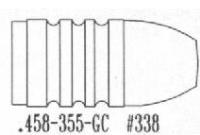
http://www.neihandtools.com/catalog/index.html
I found this bullet to be especially accurate in my marlin 45/70 over 45 grains OF IMR 4198, I'm not sure what velocity its near 1900 fps you'll get in your rifle but cast from 95% wheel weights and 5% tin, well lubed its accurate, and it shoots thru deer, hogs and elk real well with expected results. .very dead game
http://handloads.com/loaddata/default.a ... er&Source=
read these
http://stevespages.com/jpg/bestbullet.jpg
http://sixguns.com/tests/tt445sm.htm
viewtopic.php?f=96&t=9394&p=34162&hilit=aspen+mule+deer#p34162
READ
http://www.ballisticstudies.com/Knowled ... ntals.html
http://garage.grumpysperformance.co...om-friends-over-your-choice.10059/#post-73827
http://www.chuckhawks.com/energy_transfer.htm
viewtopic.php?f=91&t=1864&start=10
http://www.hornady.com/ballistics-resource/external
don,t get too concerned with the ability of the weapon you choose to do the job,
its mostly shot placement not velocity, energy and/ or bullet weight,
and your consistent ability to hit the games vitals that should concern you,
and of course, bullet construction, range and the games anatomy that matters, within reasonable limits,
every magazine article you read seems to stress the importance of hyper velocity and flat trajectory,
these factors help sell magazines and the newest super wiz-bang,
magnum rifles.
but the fact is that people were killing game very effectively,
with calibers like the 45/70 and 30/30 win, and 30/40 krag for 70-120 years,
before the newest magnums were introduced,
if you have some hunting skills you can kill game with archery equipment that has under 300fps,
and under 70 yard effective range that never reaches 150 ft lbs of energy.
THAT BEING SAID, the CALIBER, POWER LEVEL AND projectile should be matched to the intended target,
and having a bit more bullet weight or velocity seldom hurts your results either. YOU SHOULD KNOW YOUR GAME ANATOMY WELL!,
and BE able to do the job,
OF CORRECTLY PLACING A SHOT THRU THE VITALS,
under less than ideal conditions, of range and FROM entrance angles
THAT ARE NOT IDEAL,
and you must know the games anatomy,
and if you can,t consistently place shots accurately under field conditions,
what you carry won,t matter much!
under ideal conditions, almost any centerfire cartridge can kill almost any game, yet
theres ALWAYS going to be game thats well hit with any bullet design that won,t instantly fall on bullet impact,
so don,t expect that the result of a well placed hit will always DROP GAME INSTANTLY,
BUT I FIRMLY BELIEVE, AFTER DECADES OF HUNTING,
that there are advantages in use of the heavier bullets in the .260-.300 plus sectional density range,
that give you some advantages and consistency.
you should select a weapon and caliber based on what will work under the least likely,
or least favorable and not the best possible conditions of range and entrance angle on the intended game.
if you can,t use the weapon of your choice,
to quickly and effectively kill from almost any angle,
at any reasonable range you might want to rethink your choices
carry the caliber and rifle you trust,and feel confident in,
we all have different experiences, and tend to feel we need certain rifles,in our hands to feel were well equipped,
if theres one fact I've learned over 43 plus years of hunting elk and deer,
its that its the skill of the guy using the rifle,
and his confidence in his equipment, not the caliber that maters the most.
personally Id select something in the 338-358-375 caliber for elk hunting ,
and I've seen excellent results from the 338/06 and 35 whelen,
but having seen a couple elk killed with a 257 Roberts and a 6.5mm Swedish Mauser,
and even a 44 mag revolver,
I know its not so much the rifles power as it is the skill of the hunter using it,
too get into position and range to precisely place the shot in the games vitals!
IM betting your weapons effectiveness is the result of punching large holes in vital organs and massive blood loss myself, and I doubt it matters all that much if the projectile started out at 3000fps or 1200 fps as long as it passed thru and destroyed those vital organs and left a big jagged hole in its path.
while I personally prefer the 338-375 caliber cartridges throwing 200-270 grain bullets, they are not required.
Ive killed and seen far too many elk killed really dead with a 270 cal/150 grain and 30/06 cal rifles using 180-200 grain bullets to ever suggest they are not fully up to the job in the hands of a decent rifle shot, and I know most of the group I hunted with for decades used only speer, hornady, Remington and Winchester bullets......and they all worked fine when placed correctly I can,t think of any hunt Ive been on in 43 years that either of those rifles properly loaded and used correctly would not have allowed me to collect game.
the guys in my elk hunting group have tried most of the popular calibers from 257 Roberts to a 458 win and there,s one consistent fact, its the guys using the rifles skill that maters most.
and theres more guys using 35 whelens and 30/06 rifles now than magnums, Im the last guy in camp still using a 340wby or 375 H&H, there used to be several 7mm and 300 mags used, but as the guys aged and got more experience the 30/06 and 35 whelen seem to have become rather standard
Ive used a 80 lb bow with 560 grain arrows and 3 blade broad heads, a 257 Roberts, a 257 wby,a 270 win,a 300 wby , a 375 H&H, a 45/70 and a 62 caliber muzzle loader,
and a dozen other weapons the only thing that was in common was shot placement and the results, they all left a big bloody hole,
along the projectiles path thru the games body, and destroyed internal organs.
where you hits always more important than what caliber you select,
my friends dad whos near 80 years old dropped a small bull within a few feet of where he spotted it , while shooting a 257 roberts loaded with 100 grain speer bullets, on bullet impact the bull trotted about 20 yards and then got wobbly and fell , the shot was easily 240 yards, or a bit more as it was 270 plus paces to the bull from where we stood. and he made the shot leaning over a branch on an aspen with his Winchester 70 and weave 4x scope.
he hit the bull in the near side lung and angled back into the liver
that was back in the 1990s and was the last bull he ever took.
that shot really impressed me, not so much as to accuracy but how such a small cartridge could be so effective, but Ive seen guys make similar shots with 7mm and 30 calibers that had elk run further.
when I first started hunting mule deer, I read everything I could find, and I made a choice to go with a custom built ,257 wby, I had a ruger #1 built by shillen, in caliber 257 wby with a 28" barrel, it was and is accurate, it killed very effectively, it also eroded the barrel throat very slightly, in under 200 cartridges.
and while it made hits out at long range fairly easy as trajectory guess work was not all that critical out to at least 350 yards when I sighted in a couple inches high I eventually realized I had used it exactly twice in 40 plus years at ranges over 500 yards to kill mule deer and that probably 90%-95% or more of the deer Id killed had been dropped from under 300 yards.
now I don't regret building the rifle but ,
I don't see any huge advantage over a 270 win for hunting mule deer.
why, do a ballistic calculation, I doubt you'll find a 4" difference in drop even out at 500 yards between a 120 grain .25 cal. and a 130 grain .277 cal.
being a bit pragmatic I've tested a fairly wide selection of calibers on game and while Ill point out that its the bullet that does all the work and its correct shot placement ,and knowing your games anatomy that's the two most critical factors, it soon became obvious that a well constructed bullet design that held together had advantages and that as impact velocities increased too much over about 3000 fps, bullet performance seemed to rapidly fail in many cases...obviously bullet design and construction, range to the target and what your hunting effect the results, but I'm forced to point out that the my experience shows that the 257-270-30 calibers are about ideal on deer , and the slightly larger 30-375 calibers seem better suited to the elk THAT CAN EASILY WEIGHT 3-4 TIMES MORE THAN DEER.
looking around for a good answer I found this...
"It's very difficult to get a lighter bullet to have as much momentum as a smaller bullet. Momentum is mass times velocity. But energy is mass times velocity SQUARED. Therefore, to double the momentum of a bullet while keeping its mass constant, you have to quadruple its kinetic energy. To quadruple the momentum, you'd need to increase the energy by a factor of sixteen. So that's the momentum story.
Id suspect both where the bullets placed and which bullet you used , and the hunters knowledge of the games anatomy, has a huge effect on results , I've used both the 35 Whelen and 45/70 on both deer and elk in the past and had very good results.
now I've seen several deer and elk shot with a 257 Roberts and 270 Winchester rifles also and the same things hold true, place your shots well and use a decent bullet and any of the mentioned calibers work, pure physics suggests a larger more massive projectile, that expands but maintains most of its physical integrity has some potential benefits in causing more consistent and deeper wound damage, on the larger animals but I've seen a 257 Roberts dump an elk from 200 yards, in seconds after bullet impact, quite convincingly and the same thing happen with my 45/70 so I'm not overly concerned with head stamps, just accuracy and consistency.
maybe its just because I was employed for 4 decades as an engineer ,
but I've always made the choice to not take things in advertising seriously,
and preferred to deal in facts , you can look up load data,
projectile sectional density, ballistic coefficients, rifle weights,
and damn near anything else you need to compare any two cartridges
what youll find in most cases is that similar cartridges with similar projectile weight and diam and velocity,
produce similar performance. its not going to make a bit of difference in the field,
if you add or subtract a 100 fps or 5 grains of bullet mass.
what does make a difference is the rifles operator skill's,
at placing a shot carefully and the bullets physical properties,
example alloys used jacket thickness and impact velocity.
you can,t ignore physics, heavier mass and higher velocity carries more energy.
you should not ignore decades of field results, theres very few modern cartridges,
that provide any significant advantages over decades old designs like,
the 22 hornet, 22-250, 25/06 , 30/06 , 300 wby or 375 H&H.
step back mentally any time someone is bragging about the newest super zapper,
ask yourself if your current rifle has ever failed to perform well,
or if an extra few inches of flatter trajectory would make much difference.
especially if you realize that the vast majority of game is killed at well under 250 yards.
use the calculators and you'll soon realize most NEWER/BETTER- += marketing
the 22 hornet, 22-250, 25/06 , 30/06 , 300 wby or 375 H&H. will do damn near anything that's needed to be hunted,
provided you place your shot correctly and limit the range and cartridge used, to the type of animal your hunting.
22 caliber cartridges are NOT meant for large game
(yes under very limited conditions and short range in the hands of a skilled shot,
they could work on deer)

.30-30 vs .30-06: The American Sporting Caliber Debate
The 30-30 vs 30-06 is a deer hunting cartridges debate that has raged for years. It’s a question between less recoil and higher velocity for deer hunting rifles
https://www.hornady.com/team-hornady/ballistic-calculators/#!/
http://bergerbullets.com/twist-rate-calculator-3/
http://www.shooterscalculator.com/recoil-calculator.php
https://www.hornady.com/bullets/rifle/#!/
https://www.speer-ammo.com/products/bullets/rifle-bullets
https://www.hornady.com/support/load-data/
http://www.hodgdonreloading.com/
https://www.fieldandstream.com/12-best-rifle-cartridges-for-elk-hunting/
a great deal of the problems guys have with bullets results from trying to push a smaller and lighter in weight than ideal projectile to higher velocities than many bullet designs can reliably function at, you might be amazed at how consistent most cup & core bullet designs work if bullets are at least a .270 sectional density and if you don,t exceed 3000fps at the muzzle .
In terms of energy delivered to the target, a larger bullet still wins due to aerodynamic drag. Drag is a function of area. Suppose you have two bullets, A and B. They are made up of the same material and have the same shape, but bullet B is twice as large in all dimensions. It's volume and mass are therefore 8 times as large and it's drag (area) is 4 times as large as A's at the same velocity.
Suppose both are fired with the same initial kinetic energy. Since bullet A has only 1/8 of bullet B's mass, it's initial velocity will be sqrt(8) or 2.83 times higher. But aerodynamic drag, in addition to being a function of surface area, is also a function of velocity squared, so the lighter bullet will experience 8 times more drag (due to higher velocity) and (as we already computed) 4 times less drag (due to less area), for a net 2 times more drag for the lighter bullet.
It gets worse. The lighter bullet not only experiences twice the force of drag, it responds more to it. Remember F= MA, which can also be written A = F / M. In other words the lighter bullet, having 8 times less mass, will experience 8 times the deceleration when subjected to the same force. And since the drag force is actually twice as high, its decelleration will be 16 times that of the heavier bullet.
And even worse. The lighter bullet loses velocity at16 times the rate of the heavy one, but energy is a function of velocity squared, so it loses kinetic energy at 16 * 16 = 256 times the rate of the larger bullet.
Of course these are all figures for the initial conditions. As the bullets slow down they will be going closer to the same velocity, so the difference won't be quite as dramatic in the long run, but I think you get the picture.
Source(s):
Physics degree & have done work in fluid dynamics"
don,t get hung up on velocity just get the most accurate load
from a pragmatic view, I'm 100% sure there have been many dozens of elk killed with smaller 22 and 6mm rifles but that does not in my experience make them nearly ideal.
I personally have seen several elk killed very effectively with a 257 roberts, yet I would say after helping dress out those elk, and examining the internal damage that the 257 roberts is on the lower edge of the effective caliber range.
I hunt with a group of guys and most years theres 4-7 guys in camp and 3-4 deer or elk killed almost every year, this allows me to eventually see rather obvious trends in what results you can expect , and in my opinion after 45 plus years of dressing out game Id suggest a 270 win,308 win, or 7mm 08 loaded with a premium bullet is about the smallest calibers I see consistently put down game quickly and effectively


suggested bullet weights
357 mag= 158 grain-180 grain
41 mag= 220 grain-250 grain
44 mag= 270 grain-320 grain
45 caliber -300 grain-350 grain
480 caliber 350 grain-400 grain
50 caliber 400 grain-480 grain
bullet stability and twist rates
http://www.jbmballistics.com/cgi-bin/jbmstab-5.1.cgi
ballistic calculator
http://www.hornady.com/ballistics-resource/ballistics-calculator
these calculators can be really handy
ideally pistol velocity and the bullet design of the better hunting ,
cast bullets are most effective if the melplat (nose) is flat ans between 75%-80% of the bullet diameter, its a gas check design and its pushed to a muzzle velocity of at least 1350 fps but not too exceed about 1800 fps and have a bullet in the .240-.260 sectional density range.
jacketed hollow points should be used only on lighter weight game like deer.
remember the proper hard cast bullet will penetrate very effectively but it won,t expand rapidly, thus a knowledge of the games anatomy and locations of the vital organs is critical to rapid kills.
don,t be surprised if the first few large game animals you shoot run off with little indication they were hit, unless you place shots precisely handgun kills will resemble archery hunting and it will take 30 seconds for the game to bleed out, and in 30 seconds a scared injured deer can travel 200 yards making its recovery difficult.
but place shots precisely and if you used the correct projectile, distances will be much less.
https://www.fieldandstream.com/12-best-rifle-cartridges-for-elk-hunting#page-13
http://www.chuckhawks.com/sd.htm
Sectional Density Calculator
http://www.beartoothbullets.com/rescources/calculators/php/density.htm
http://www.hornady.com/ballistics-resource/external
bullet stability and twist rates
http://www.jbmballistics.com/cgi-bin/jbmstab-5.1.cgi
ballistic calculator
http://www.hornady.com/ballistics-resource/ballistics-calculator
http://www.midwayusa.com/product/740066 ... -box-of-20
even a fairly small cartridge like a 44 mag in a carbine or revolver can be quite effective in experienced hands inside of reasonable ranges, this federal 44 mag ammo looks like a good selection,if you don,t hand load, but id point out that with cast flat nose bullets performance is dependent on a good knowledge of the games anatomy and very precise ,and correct shot placement.
a shot thru the green dot will be quickly fatal, place the shot a bit higher and forward to destroy the shoulder and spine if your more concerned with anchoring the animal quickly than maximizing the venison,you pack out
have to point out a fact that all too many guys either ignore or never considered,
the projectile does ALL the work and damage! where you hit on the animals anatomy,IS CRITICAL
rapid lethality depend on where you place the projectile and how much damage is done.
and how much damage to vital organs and/or skeletal structure,being done,
should obviously be considered the major factor in potential lethality expected.
small fast expanding projectiles are devastatingly lethal... IF placed correctly,
IF THEY destroy the heart/lung area but the deer can still run very fast and
well for up to 10 seconds or so , and they may not leave much of a blood trail,
larger more heavily constructed projectiles, like a 180 grain 30 cal, or a 250 grain 358 bullet open slower and in a far more controlled manor ,
they may not do as much damage to the lungs,initially but they are 100% lethal if shots are well placed.
and frequently leave a blood trail.
and they do tend to be much more consistent and reliable at busting skeletal structure,
provide deep penetration through muscle and they do tend to leave exit wounds more often.
if you hand-load you can custom fabricate ammo specifically matching your requirements.
traditional brush cartridges like a 45/70 or 444 marlin can provide exceptional penetration,
(especially if loaded with heavy for caliber cast bullets,)(these can be depended on to exit deer )
or be loaded with fast expanding hollow point bullets to give rapid expansion.


(1) where you place the shot is critical (know the games anatomy)
(2) use of a heavy for caliber projectile tends to greatly aid deep penetration
(3)the larger caliber and heavier the projectile, used the more consistent deep penetration
(4)deep penetration is a plus only if you use it to destroy vital organs,(heart/lungs)
and critical structure like spine and shoulders, (see #1)
PEOPLE HAVE KILLED 800LB GRIZZLES WITH A 22LR, BUT THAT HARDLY MAKE THAT THE IDEAL SELECTION
range effects the bullets retained energy, a 44 mag loaded with a 300 hard cast bullet at 50 yards makes a good deer & elk cartridge even at only 1200fps but stretch the range to 300 yards and its far less useful, and it carries far less punch, or momentum.
if your looking for a decent caliber/cartridge to hunt with, you'll be well served to do a bit of research on the average ranges, and game anatomy your intending to hunt ,and select a commonly used cartridge used for that game, you can easily get by with only a few common calibers, like the 22lr,223 rem,25/06,30/06,300wby, 338 mag, and 20ga,3" 12 ga for all north American hunting, and obviously there's a hundred other choices, but for big game a simple combo of two rifles , similar to,a 270 win loaded with a good 150 grain bullet and a 338 mag loaded with a good 250 grain bullet will handle 99% or more north American big game hunting conditions in skilled hands, either caliber could be used for most conditions or a compromise like a 35 whelen in a good rifleman's hands could also be very effective.
Id suggest selecting a cartridge with minimums of 150 gain bullet weight and 2500fps muzzle velocity and you don,t need more than 3000fps and 270 grains of bullet for anything I can think of in north America.
average both and you get about 210grains of bullet at about 2750fps and the 35 whelen, the 300 mag and 338 mag all fall in that range
personally I vastly prefer a complete pass thru and exit, but I want the bullet to expand and do some damage while in transit, I try for heat / lung shots and not to break large bones, I've found that limiting the bullet selection to the .338-through.458 calibers and selecting a bullet with at least 250 grain weight, and being rather selective in bullet placement, rather than just shooting at any thing you see,with fur goes a long way to getting the desired results while knowing the intended targets anatomy helps a good deal in achieving that desired result
Ive seen 4 elk killed with a friends dads 257 roberts and its lethal, in skilled hands, but I'd also point out that most of the successful hunters in years past knew how to hunt and seldom would attempt shots at the ranges I see guys quote frequently today. my friends dad killed all his elk well inside of 250 yards and he waited for a good shot angle before squeezing off a shot, if your going to use a smaller caliber pure physics, and the games anatomy, restricts you from expecting to get away with some of the shot angles you could effectively pull off successfully with a significantly heavier projectile, of larger caliber.
no matter how you try, you can't get away using a 243 win or 257 Roberts at the same extended, ranges and odd angles that a 280 rem,- 30/06-300 mag,-375 H%H loaded with heavy bullets can deal with, successfully.
used within a reasonable range and handled correctly with a well practiced shooter, I've seen rather remarkable results , but those are still limitations that the shooter should be aware of, that are not quite as restrictive on its use as a larger caliber.
personally from the results I've seen I think a 270 win loaded with a good 140-150 grain is where ID start as a good dependable ,low recoil,elk rifle
heres some suggestions from years of experience, you may not hunt thick timber most of the time like I do, but it won't hurt to know what works at moderate ranges on elk either.
the 250 hornady in .338 at about 2600 fps
http://handloads.com/loaddata/default.a ... er&Source=
or 340 wby at about 2800 fps
the 250 speer used in the 358 win at about 2300 fps and 35 whelen at about 2500 fps
the 270 hornady in a 375 H&H at about 2500 fps
http://handloads.com/loaddata/default.a ... er&Source=
the 405 remington in a 45/70 at about 1800 fps
the

http://www.neihandtools.com/catalog/index.html
I found this bullet to be especially accurate in my marlin 45/70 over 45 grains OF IMR 4198, I'm not sure what velocity its near 1900 fps you'll get in your rifle but cast from 95% wheel weights and 5% tin, well lubed its accurate, and it shoots thru deer, hogs and elk real well with expected results. .very dead game
http://handloads.com/loaddata/default.a ... er&Source=
read these
http://stevespages.com/jpg/bestbullet.jpg
http://sixguns.com/tests/tt445sm.htm
viewtopic.php?f=96&t=9394&p=34162&hilit=aspen+mule+deer#p34162
READ
http://www.ballisticstudies.com/Knowled ... ntals.html
http://garage.grumpysperformance.co...om-friends-over-your-choice.10059/#post-73827
http://www.chuckhawks.com/energy_transfer.htm
viewtopic.php?f=91&t=1864&start=10
http://www.hornady.com/ballistics-resource/external

